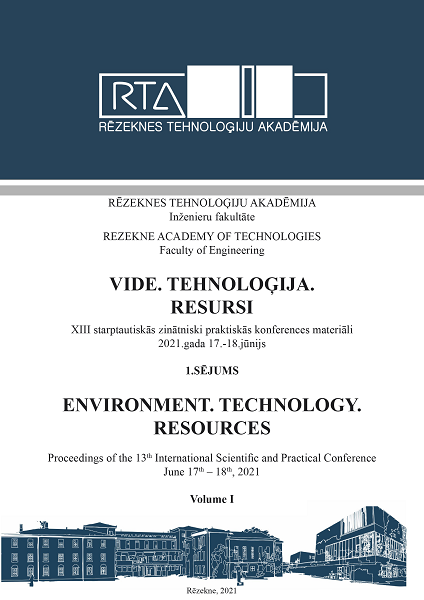REVIEW OF CHARACTERISTICS OF ALNUS GLUTINOSA STANDS QUALITY ACCORDING TO FOREST TYPES AND AGES
DOI:
https://doi.org/10.17770/etr2021vol1.6610Keywords:
Alnus glutinosa, Dryopterioso-caricosa, Myrtillosa, Myrtillosaturf.mel, Oxalidosa, Myrtilloso-sphagnosa, Oxalidosa turf.melAbstract
Due to the interest in Alnus glutinosa as the plantation species has increasesed in Latvia during last years, a structural unit “LVM Sēklas un stādi” of State Stock Company “Latvijas Valsts Meži” (Latvia’s State Forests) offers to the local market Alnus glutinosa bare root seedlings with an advanced root system obtained from Alnus glutinosa seeds growed in planting such selected seedlings in cutovers and for land reforestation theorectically will allow the land owner to increase the value of forest and the profit from its management. Practically, this prospects should be evaluated from the perspective of forest health.
Therefore, the purpose of this study were to: (1) estimate the incidence of heart colouring and stem decay in Alnus glutinosa stands in different forest types and ages, (2) identify and measure heart colouring area /heartwood hard rot stage area diameter and soft rot stage area diameter/ cavity diameter of the stumps, (3) evaluate the relationships between stand species composition (forest types) and Alnus glutinosa stands age on heart colouring/heartwood hard rot stage and soft rot stage/cavity incidence, (4) by analysing the results to work out the recommendations to improve the forest managment in forest stands where Alnus glutinosa stands from plantations are growing.
Downloads
References
N. Arhipova, T. Gaitnieks, J. Donis, and J. Stenlid, “Heart rot and associated fungi in Alnus glutinosa stands in Latvia”. Scandinavian Journal of Forest Research, 27 : 2012, pp. 327-336.
N. Arhipova, J. Donis, T. Gaitnieks, and I. Liepa, “Root and butt rot causing fungi: the impact of broadleaved species admixture on the indicence of Heterobasidion spp. in spruce stands”. Mežzinātne 22 (55): 2010, pp.70-87.
G. M. Bond, W. Fletcher, and Ferguson, T, “The development and function of the root nodules of Alnus, Myrica and Hippophae.” Plant Soil. 5, 1954, pp. 309-323.
H.Claessens, L’aulne glutineux. Ses stations wet sa sylviculture. ASBL Fore Wallone, 2005, 189 p +2 annexes
H. Claessens, A. Oosterbaan, and P. Savill, “A review of the characteristics of black alder (Alnus glutinosa (L) Gaertn.) and their implications for silvicultural practices”. Forestry, 2010, Vol, 83, No. 2
H. Claessens, “The alder populations of Europe”. For. Comm. Bull. 126, 2003, pp. 5-14.
T. Immler, T, “Waldbauliches Konzept zur Pflege der Schwarzerle. In Bayerische Landersanyalt fur Wald und Forstwirtschalf, Beitrage zur Schartzerle”. LWF Wissen 42, 2004, pp. 27-30.
K. Korhonen and O.Holdenrieder, “Neue Erkenntnisse uber den Wurzelschwann *(Heterobasidion annosum s.l.) ”. Eine Literaturubersich. Forst and Holz 5: 2005, pp. 206-211.
J.N. Koster, Die Wurzeln der Waldbaume. Paul Parey, Hamburg, Germany 1968,284p.
K.W. Lockow, and S. Chizon, Diagnose des Roterlenkernfaule am stehenden Stamm. AFZ/Der Wald. 51, 1996, pp.1367-1371.
V. Lygis, R. Vasiliauskas, J. Stenlid, and A.Vasiliauskas, “Silvicultural and pathological evaluation of Scots pine afforestations mixed with decidous trees to reduce the infection by Heterobasidion annosum s.s.” Forest Ecology and Management, 201. 2004, pp. 275-285.
Meža enciklopēdija. (Forest encyclopedia) 1.sējums. R.; apgāds ”Zelta grauds” 2003. 368 lpp.
V. Ņesterovs, Vispārīgā mežkopība. (General forestry). Latvijas Valsts izdevniecība. 1954, 610 lpp.
T. Piri, K. Korhonen, and A. Sairanen, “Occurrence of Heterobasidion annosum in pure and mixed stands in southern Finland”. Scandinavian Journal of Forest Research 5: 1990, pp. 113-125.
C.M. Popovska and D. Ivanovski, “Disturbed river corridors and protection measures”. Balwois 27, 31 May Ohrid, Republic of Macedonia, 2008, pp. 1-7.
N. Priedītis, “Black alder swamps on forested peatlands in Latvia.” Folia Geobotanica &Phytotavonomica, 28, 1993, pp. 261-277.
A.M. Thibaut and H. Claessens, Construction de tarifs de cubage d’arbres pour l’aulne glutineux (Alnus glutinosa L.Gaertn). 1998. Biotechnol. Agron. Soc. Environ. 2, 2003, 214 p.
I. Vyhlidkova and D. Palovčikova, “Some aspects of alder decline along the Lužnice River”. Journal of Forest Science, 51, 2005, pp. 381-391.


